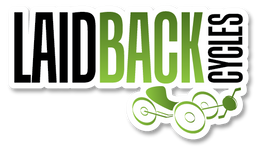
About this time last year, TerraTrike’s model line-up was approximately as long and confusing as a Leonardo DiCaprio film. There was the Rover, Rambler, Path, Cruiser, Tour, Zoomer and Tandem. To make matters even more complicated, most of those models were available in several different trim levels. This was all fine and good when TerraTrike was a smaller manufacturer, but now that they’ve grown into the largest recumbent company in the country, something had to change.
The Path, Cruiser and Tour all used pretty much the same frame so combining those three lines into one seemed like a pretty logical step. That basic design has been around for a decade and a half so it also seemed like a smart to make a few updates. And thus was born the Tour II.
The Tour II’s frame shares the same frame geometry as the outgoing Path/Cruiser/Tour models. However, some bits of the steering linkage have been changed to improve the trike’s turning radius. It’s still made of chromoly steel and has the same mesh seat that comes on all TerraTrike models. When I heard that this project was coming, I expected that TerraTrike would go with a sliding boom but they chose to remain with the current three-size system. However, they did make one major change in the area of size adjustment. The new sliding seat mount is infinitely easier to use than the old bolt-through-the-hole seat mount. It also allows much more fine adjustment. The old Tour was one of the most difficult trikes to adjust on the shop floor. The Tour II is now one of the easiest.
In order to cover all of the pricepoints that were occupied by the Path/Cruiser/Tour trio, the Tour II comes in three different specs starting with a $1399 8-speed model and culminating in the $2399 blinged out Pro Model. I chose the $1599 Base Model for this test. Last year this would have been a Cruiser which has always been one of my favorite TerraTrikes.
Since the Tour II comes with such a wide range of component choices, I won’t get into every little detail here but I will say that the Base Model’s 24-speed MicroShift drivetrain and Bengal disc brakes all worked without issue. You don’t see a lot of MicroShift components out there but they all seem to work great. Other than the shifter action being a bit on the heavy side, it all felt just as nice as anything from SRAM or Shimano. My only real gripe with the components is the same one I’ve had with TerraTrike for a long time now. I just don’t see why they continue to insist on putting 40 psi tires on most of their trikes.
I also ordered our test trike with the optional 26” rear wheel extension kit. I’ll start this review with the more common 20” stock wheel set-up and then review the 26” version at the end.
When you order a trike direct from TerraTrike it arrives fully assembled. All I had to do was cut open the box, lift it out and ride away. Everything on the trike was perfectly adjusted. It couldn’t be easier and the shipping isn’t even that expensive.
The Tour II comes in a bright yellow color that is quite eye catching and really seems to fit the trike well. It also comes with three different colored sticker kits. Silver, Blue and Brown. This is something that TerraTrike is doing on a lot of their trikes now. It’s cool in that it allows owners to personalize their machines a bit. However, I really wish that the Tour II came with black stickers to match the ones that are already on the trike.
I’ve always thought that this particular family of TerraTrikes were very comfortable. The Tour II is no exception. The seat adjusts to a wide variety of angles, is plenty wide enough for most body types and breaths very well. The frame is compliant enough to soak up most smaller bumps without rattling your teeth and the controls all fall readily to hand.
As I mentioned above, TerraTrike made a change to the Tour II’s steering linkage to allow a tighter turning radius. This was a much needed improvement. The Tour II still doesn’t exactly turn on a dime but it’s now much more in line with those of the competition. The steering feels a bit lighter overall but the change didn’t seem to effect the high speed handling at all. The Tour II is a very easy trike to handle up to about 25 mph or so but does require your full attention over 35 mph.
The Tour II isn’t marketed as a performance trike. It says “Tour” right in the name, but I found its speed potential perfectly acceptable in my day-to-day usage. The Tour II does have a lot of idlers and I’m sure there’s some loss in driveline efficiency but everything runs smoothly and relatively quietly.
TerraTrike does offer a full line of accessories to go with the Tour II. You can order racks, fenders, seat bags, panniers, flags and a host of other goodies right from the company. Since this frame design has been around for so long, there are also a slew of aftermarket upgrades available.
So is this old bird totally modernized? Not completely. There’s still a bit more brakesteer than you find in some trikes and there are still a lot of chain idlers. But the Tour II is definitely a much more viable contender than it was last year, especially when you look at the prices of the lower end versions. It’s not easy to get a high-end 24-speed trike at this price. You also can’t find a company with better customer service reviews than TerraTrike. The Tour II is also a stout, well crafted platform that’s well worth upgrading later on if you so choose.
TOUR II 26
As I said before, I also asked TerraTrike to send me the 26” wheel upgrade for our test trike. Installation was shockingly simple. TerraTrike even provided a pre-cut length of change that was the perfect size to make up for the trike’s additional length. The whole process took less than half an hour.
I reviewed the old Tour with the 26” kit a couple of years ago and liked it a lot more than the standard 20” trike. The effect on the Tour II was pretty much the same. I really feel that it makes a good trike even better. It’s rolls faster, is more stable at speed and (in my opinion) looks better than the stock version. You do lose a few gear inches on the low end, but that’s a small price to pay.
The Tour II 26 isn’t exactly a wedgie-hunter when it comes to performance but it’s pretty quick for a trike. It definitely was fast enough to make me one of the more rapidly moving entities on the bike path.
It also makes the Tour II a bit more comfortable on rougher roads. Bumps that made me wince with the 20” wheel were much less spectacular with the 26”.
The only downside I found was that if you use the 26” rear wheel, lay the seat all the way back and put too much stuff in the seat bag, it may rub a bit.
The price of this substantial upgrade is between $145 and $214 depending on which model of Tour II you have. Unless you really need the lower gear inches of the 20” wheel, I’d say that this upgrade is a no-brainer.

